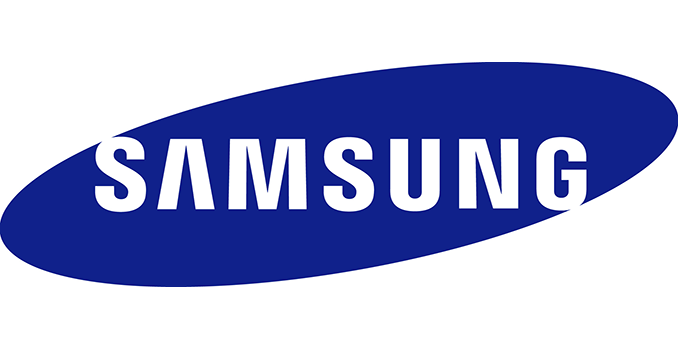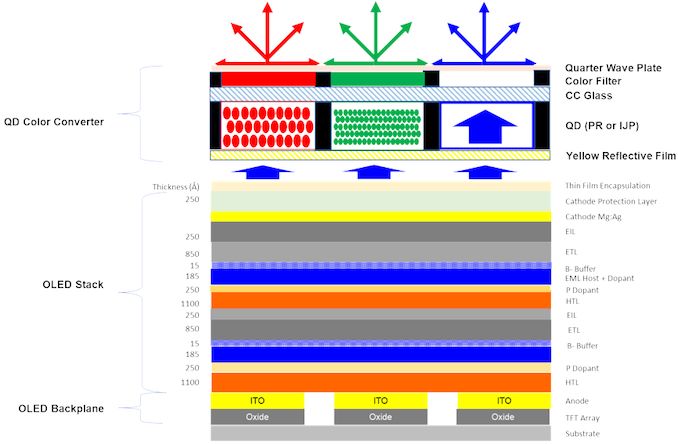Samsung to Invest $11 Billion in QD-OLED Panel Production
by Anton Shilov on October 15, 2019 5:30 PM EST
Samsung Display has announced plans to invest a further ₩13.1 trillion ($11 billion) in the R&D and production of QD-OLED TV panels. The plan includes building up two QD-OLED production lines in South Korea between now and 2025, with the first starting production in 2021. In addition, the company will invest in R&D of quantum dot-enhanced OLED technology, which promises to provide finer colors than today’s OLED displays and televisions.
The first step of Samsung’s QD-OLED plan will be converting its L8 fab in Tangjong, South Korea, from making LCD substrates to QD-OLED substrates. The plant is expected to produce 30 thousand QD-OLED substrates per month starting in Q1 2021. Longer term, Samsung will be converting all of its 8th Generation LCD production facilities to QD-OLED in a bid to increase the number of substrates produced monthly to 100 thousand.
The QD-OLED technology promises to simplify (i.e. lower the cost of) production of OLED-based televisions and monitors, as well as enabling wider color gamuts, which is something expected from next-generation content. Contemporary WOLED panels from LG Display use a blue or white (yellow + blue) OLED emitter stack, and a WRGB color filter system on top with a variety of additional layers behind, between, and ahead of them. By contrast, a QD-OLED panel uses an OLED emitter stack (some believe, with two emitting stacks) with a quantum dot RGB color filter (also called quantum dot color converter, or QDCC) system on top.
Today’s OLED panels feature 22 layers, whereas a QD-OLED panel may cut the number to 13, which means fewer deposition stages, lower material and production costs, and, perhaps, better yield. The QD-OLED technology is still considered to be rather challenging as Samsung has to solve light management issues. Meanwhile, according to Display Supply Chain, one square meter of an QD-OLED panel will cost around $26, whereas one square meter of a contemporary OLED panel costs approximately $95.
Lee Dong-hoon, CEO of Samsung Display, had the following to say:
"Quantum dots are semiconductor particles which luminate close to natural colors. It is the future growth vision of the large display industry. With the investment we will lead the premium display market."
Related Reading:
- Samsung Mulls Suspending South Korea LCD Plant Due to Oversupply
- Samsung Acquires Quantum Dot Tech Company QD Vision
- Samsung’s 8K QLED TV 55-Inch: A More Affordable 8K Ultra-HD TV
- 8K Association Sets Minimal Specs for 8K Ultra-HD TVs
- Sharp to Demonstrate 120-Inch 8K LCD TV & 8K TV with 5G Modem at IFA
- AU Optronics's New 85-Inch 8K LCD TV with 1,024-Zone Backlighting
- Samsung's 2019 QLED UHD TVs: 8K TVs Revamped, 4K TVs Get New Panel & Backlighting
Sources: Reuters, Nanosys, The Investor, Nikkei, DSCC, OLED-Info












42 Comments
View All Comments
nevcairiel - Wednesday, October 16, 2019 - link
Actually the problem with microLEDs is the opposite - its harder for smaller screen sizes since getting the density is the problem.They can make a 100-inch display with a relatively low resolution (for that screen size) no problem, but a 60 inch at 4K, thats too much density.
peevee - Wednesday, October 16, 2019 - link
"So, kind of like an LCD"Not at all, more like a CRT, only instead of beams of electrons the luminescence is activated by beams of blue light, with one emitter per subpixel instead of one emitter per color.
s.yu - Thursday, October 17, 2019 - link
Oh yeah, much like a CRT.quiksilvr - Tuesday, October 15, 2019 - link
I never would have thought Samsung was going to go the OLED route given their huge push for QLED and microLED tech. I honestly believed they were going to leapfrog past OLED onwards to microLED. Guess LG is now thoroughly screwed in this realm too.nathanddrews - Tuesday, October 15, 2019 - link
You mean like how they have been pushing OLED for mobile devices for nearly a decade?quiksilvr - Wednesday, October 16, 2019 - link
Exactly. They have been doing that forever and said time and time again that OLED doesn't make sense for a TV because of the burn in issues. That was the main reason why Plasma died out.peevee - Wednesday, October 16, 2019 - link
I have 2 plasma TVs, one (Panasonic) is >>10 y/o, and no burn in.Plasma TV died out because their production costs are much higher than LCDs, and the market is price-sensitive.
s.yu - Thursday, October 17, 2019 - link
And very inefficient...wr3zzz - Wednesday, October 16, 2019 - link
Plasma was abandoned because Japanese couldn't make 4K plasma panels when the Koreans flooded the market with 4K LCD TV long before any 4K content was available. Japanese was also late in pushing 4K LCD. That strategic mistake more than anything else, not plasma burn-in, shifted the TV market dominance from the Japanese to the Koreans.lilkwarrior - Wednesday, October 16, 2019 - link
Numbers don't lie: OLED dominates high-end panel sales, especially TVs (Samsung dominates the lower-end TV market).It only makes sense Samsung does this.